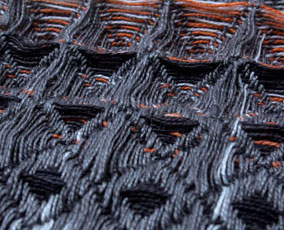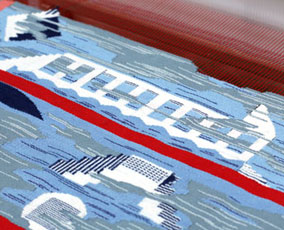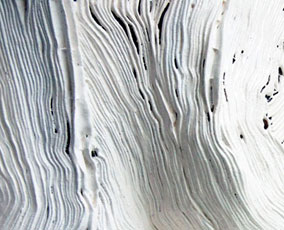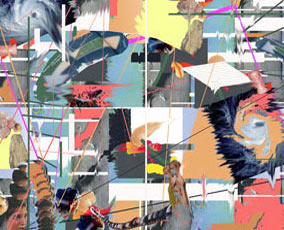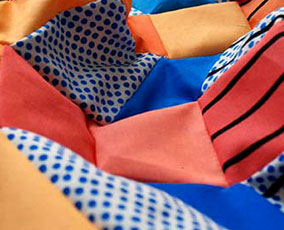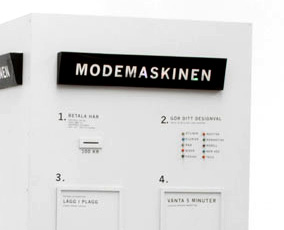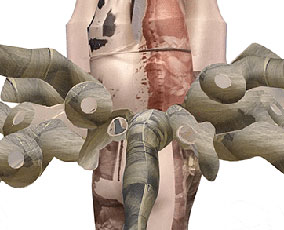Konstfack Degree Exhibition 2014 / Vårutställning 2014
Textile is constantly present in our lives, as a part of almost all human activity. It is also present as an absence, nudity is scantily clad and nudists challenge the world with their absence of a textile layer between bottom and chair. The many hours we spend with textiles makes us speak advanced textile languages and an image of textile triggers a number of layers of knowledge, categories and tactile understanding.
Many possess a greater knowledge than they are aware of regarding how materials will age, smell and move, where they belong when it comes to class, gender, culture and historical period.
Language is full of textile metaphors: “the weave of life”, “intertwine”, “common thread” etc. But textile itself also carries codes and values that reflect the current social and financial systems, which makes textile a possible double agent, as metaphor and evidence.
The insatiable personal desire for textiles has, for better or for worse, contributed to global trade and the complex production we have today, but it can also be what connects us and allows us to find solutions together.
Textile is cooperative in nature, it always seeks new co-existences; a body that carries it, a pole to hang from, the wind, something to cover, present, give life to, carry and protect. In this exhibition, which marks the beginning of the students’ professional lives, you become the collaborator, and together we create the friction needed for new knowledge to emerge. From now on.
Abigail Janjic’s monumental installations use repetition, digital prints, painting and screen prints to achieve a physical experience of the image. Janjic considers the image as a prisoner in the digital world and uses the friction of the materials to free it. She makes us raise our gaze from our iPhones and rediscover the space.
Ida Pettersson’s great patchwork quilts are as much physical as visual experiences. In her works she allows various associations and connections from art and popular culture to collide and intermingle by utilizing the textiles’ qualities and colors she makes us remember the connections between the wave mane of the My Little Pony figurine, Bridget Riley’s op-art curves and the flapping shorts of a surfer.
Carolin Muller looks at how the female body is exhibited, controlled and admired in a work where the department store’s pantyhose-female leg-displays and the woman’s tightly controlled, shaved and braided hair is reshaped into an equally beautiful and painful chandelier.
Hannah Waldron develops and examines the possibilities of contemporary story telling in tapestry form. She bases her work on texts that use textile references and experiences. Patti Smith, Italo Calvino and Einstein’s stories and metaphors meet friction in weaving techniques, creating new stories.
Matilda Dominique’s pragmatic and metaphysical examinations in weaving tries to make use see, discover and appreciate the complex and beautiful woven systems that surround us. She plays with the scale of the waffle weave’s repetition and the thickness of the thread so that physical close-ups make us aware and provide us with physical intellectual stimulus.
In Gabriella Loeb’s sculptures, the soft fabric has hardened and set in a shape that, through the ecstasy of the Baroque and perfection of Haute Couture, becomes a dance with un-wearable clothes where sharp pins pierce the material like missiles.
Elisabeth Axelsson presents a suggestion for how future fashion designers could cooperate with consumers to reach emotional sustainability, something which would make us care for our garments for a long period of time. She has made a functioning full-scale drawing of a different fashion house where we as users participate in enriching our old clothes, or change the appearance of work clothes to indicate shared responsibility and shared enjoyment. Indigo and gold. Everyone is a king.
Bella Rune, artist and Professor of Textiles
Språket är fullt av textila metaforer: ”livets väv”, ”sammanfläta”, ”följa trådar” osv. Men textilen själv är också bärare av koder och värden som avspeglar de rådande sociala och ekonomiska systemen, detta gör textilen till en möjlig dubbelagent, metafor och ett bevismaterial.
Textil är ständigt närvarande i våra liv, som en del av nästan all mänsklig aktivitet, även närvarande som avsaknad, nakenhet är lättklätt och nudister utmanar med frånvaron av det textila lagret mellan rumpa och stol. Våra många timmar med textilen gör att vi talar avancerade textila språk och även en bild av textil triggar en mängd olika lager av kunskap, kategorier och taktil förståelse.
Många besitter större kunskap än de förstår om hur materialet kommer att åldras, lukta och röra sig, var det hör hemma i klass, kön, kultur och historisk period.
På många sätt är textilen både grunden till, och beviset för mänsklig intelligens och vår förmåga att skapa komplicerade system, som t.ex. binär digitalteknik, sprungen ur hålkorten i Jacquards vävstol. Den omättliga individuella längtan efter textil har, på gott och ont, bidragit till global handel och den komplexa produktion vi har idag, men den kan ju också vara det som sammanbinder oss och ger oss möjligheter att tillsammans hitta lösningar.
Textilen är samarbetsvillig till sin natur, den söker alltid efter nya samexistenser; en kropp som bär upp, en stång att hänga i, vinden, något att täcka över, presentera, ge liv till, bära och skydda.
I utställningen, som är början på studenternas professionella liv, blir du den medarbetaren, tillsammans bildar vi den friktion som behövs för att nya kunskaper ska kunna ske. Nu börjar det.
I Abigail Janjic monumentala installationer använder hon sig av repetitioner, digitaltryck, måleri och screentryck för att åstadkomma en fysisk upplevelse av bilden. Janjic ser bilden som fånge i det digitala och använder sig av materialens friktion för att befria den. Hon får oss att lyfta blicken från vår Iphone och återupptäcka rummet.
Ida Petterssons stora lapptäcken är lika mycket en fysisk som visuell upplevelse. I verken låter hon sina olika associationer och kopplingar från konst och populärkultur krocka och samsas och genom att utnyttja tygernas kvalitéer och färger får hon oss att förnimma banden mellan My Little Pony-hästens vågiga man, Bridget Rileys opkonsts kurvor och surfarens fladdrande shorts.
Carolin Muller vänder sin blick mot hur kvinnokroppen ställs ut, kontrolleras och beundras i ett verk där varuhuset strumpbyx-kvinnoben-skyltning och kvinnans hårt kontrollerade rakade och flätade hår omformas till en lika vacker som smärtsam ljuskrona.
Hannah Waldron utvecklar och undersöker möjligheterna för samtida berättande i bildväv. Hennes utgångspunkt är just text som pekar mot textila referenser och erfarenheter. Patti Smith, Italo Calvino och Einsteins berättelser och metaforer möter friktion i vävtekniker och nya berättelser skapas.
Genom Matilda Dominiques både pragmatiska och metafysiska undersökningar in i väven söker hon att få oss att se, upptäcka och uppskatta de komplexa och vackra vävda system som omger oss. Hon leker med skalan på våffelvävens repetition och trådens tjocklek så att fysiska närbilder gör oss uppmärksamma och ger oss fysisk intellektuell stimulans.
I Gabriella Loebs skulpturer har det mjuka tyget stelnat och frusit till en form som genom Barockens extas och Haute Couture-sömnadens perfektion blir till en dans med o-bärbara kläder där vassa nålar trycker sig igenom materialet som missiler.
Elisabeth Axelsson visar ett förslag på hur en framtida modedesigner skulle kunna samarbeta med konsumenten för att uppnå emotionell hållbarhet, något som får oss att vårda plagget under lång tid. Hon visar en fungerande fullskaleskiss av ett annorlunda modehus där vi som användare är delaktiga i att förädla våra gamla plagg, eller styra utseendet på arbetskläder som pekar mot att det är delat ansvar och delad glädje. Indigo och guld. Alla blir kung.
Bella Rune, konstnär och professor i textil
